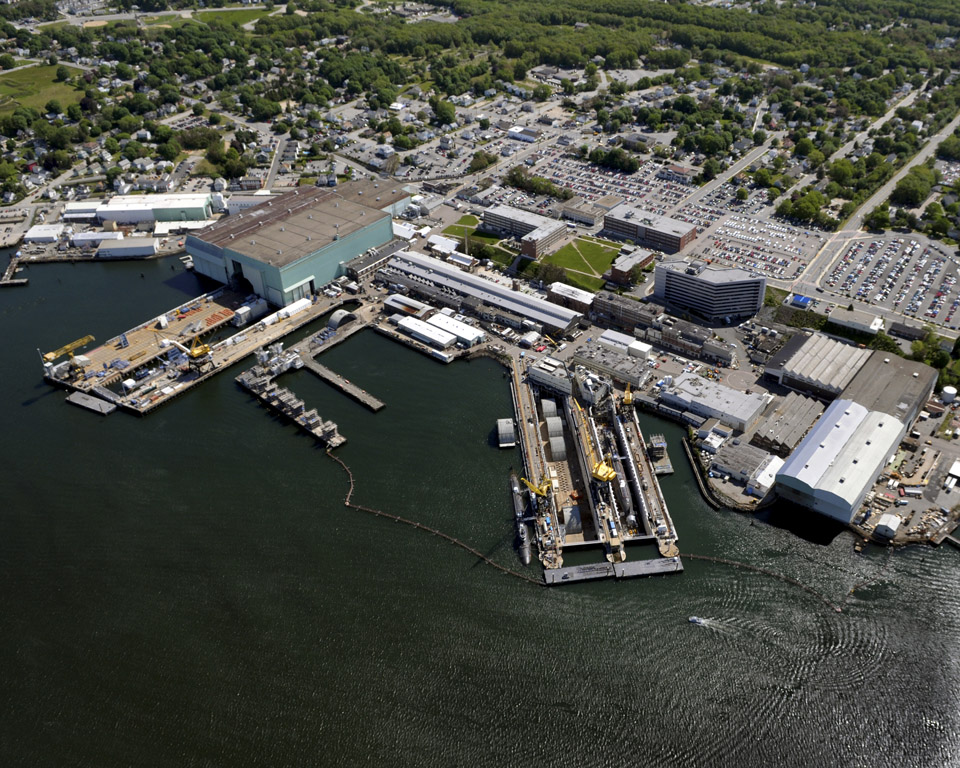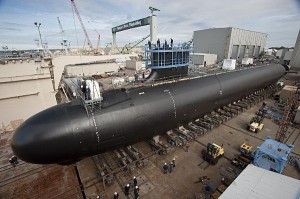Ohio Replacement Plan Is Good News For Electric Boat
Posted on

Electric Boat’s submarine-building yard in Groton, Connecticut
The Navy’s plan for building new nuclear missile submarines — the $80 billion Ohio Replacement Program — tips the balance between the nations’ sub-builders in favor of New England-based Electric Boat. Yes, the “Submarine Unified Build Strategy” carefully allocates work between EB, owned by General Dynamics, and Virginia’s Newport News Shipbuilding, owned by Huntington-Ingalls. Yes, the strategy was agreed to by both companies. Yes, there’s plenty of work to go around. But nevertheless the Yankee yard comes out ahead.
Electric Boat will do all final assembly for all 12 Ohio Replacement Program subs — each of which is roughly twice the size of a Virginia. Newport News will continue building key components, but it won’t do any of the final assembly. By contrast, under the current longstanding arrangement, Electric Boat and Newport News share equally in the work — and profits — for the Virginia-class attack submarine. (For a detailed analysis, read Congressional Research Service analyst Ron O’Rourke, who figured the plan out from Assistant Navy Sean Stackley’s testimony a month ago). Going forward, though, the Navy expects Electric Boat to get almost 80 percent of the Ohio Replacement work. In return, Newport News will get a larger share of work on the Virginias— but the plan doesn’t specify how much, because the Navy doesn’t know how much it’ll have to divvy up.

The Virginia-class attack submarine USS Minnesota under construction in Newport News.
In the current setup, each yard specializes in building certain components, but take turns doing the final assembly, which includes the sensitive nuclear reactor work. (EB and NSS are the only yards left in the US that can build nuclear-powered vessels; NNS has an outright monopoly on aircraft carriers). Historically, the final assembly work was split 50-50, but the current block-buy contract for 10 Virginias is six to four in EB’s favor.
The Navy now buys two Virginias a year, one from each yard, and it desperately wants to keep buying two a year to keep pace with the rapidly growing Chinese navy. “The service can’t stop building multiple Virginias each year because the fleet would shrink to a point where it can’t cover intelligence gathering and other missions around the world,” said defense industry analyst and consultant Loren Thompson. “On the other hand, it must replace retiring Ohio-class ballistic-missile subs which carry most of the warheads in the nation’s nuclear deterrent” — which is increasingly relevant as China and Russia both grow more aggressive.
But even the Navy’s notoriously optimistic 30-year shipbuilding plan admits the service can’t afford all the vessels it needs. The official long-term forecast predicts Virginia production will drop to one attack sub in the years when the Navy also has to buy an Ohio Replacement.
Further complicating the calculations is that future Virginias will be larger and more expensive than the current ones, though they will be still far smaller and cheaper than Ohio Replacements. Since the fleet’s four cruise-missile submarines are aging out of service, the Navy wants to upgrade the Virginia class with a “Virginia Payload Module” that triples its cruise missile capacity. That’s a major military advantage that requires a major increase in workload.
“The Navy’s goal is make sure work is spread around so that neither Electric Boat nor Newport News is overburdened” or underused, said Thompson. Too much work at a given yard creates logjams and delays; too little, and the skilled workforce erodes for lack of practice.
So the Navy, as always, must carefully manage its industrial base, which is what this plan’s about. The open secret of naval shipbuilding is that good old-fashioned cutthroat competition is long dead, and the current market is much closer to how the Soviet Union allocated work between rival design bureaus — MiG and Sukhoi, for example — than to any kind of capitalism.
“With the introduction of OR [Ohio Replacement] and VCS with VPM [Virginia-class submarine with Virginia Payload Module], there is a significant increase to the workload of the nuclear shipbuilding industrial base,” Navy spokesperson Capt. Thurraya Kent wrote in an email. “During the time of OR submarine production, HII-NNS [Huntington Ingalls Industries – Newport News Shipbuilding] will perform approximately 22-23 percent of the work on OR as a subcontractor….. Given the priority of the OR Submarine Program, the delivery of VCS will be adjusted with HII-NNS performing additional deliveries.”
Note Capt. Kent doesn’t specify how many “additional deliveries” of Virginias there’ll be, if any. That’s because the Navy doesn’t know. The plausible worst case is zero.
It’s also worth noting that the new plan came from the Navy, which then got the companies to buy in. By contrast, the current division of labor on Virginia-class subs came from the companies, which then got the Navy to agree. “The VCS teaming agreement is between the shipbuilders and was developed at the start of VCS construction,” Kent said. “This optimal Submarine Unified Build Strategy was developed by the Navy and agreed to by the shipbuilders.”
All that said, a rising tide should lift all boats — or make it easier for them to submerge — and the tide is definitely rising for submarines as Pentagon leaders refocus from guerrilla warfare to naval battles and nuclear deterrence against Russia and China.
“Submarine work will be a growth market over the next 10 years,” said Thompson. “If I was picking a theme song that captures the meaning of this agreement for the submarine industry, it would be ‘Happy Days Are Here Again.’ This segment of the defense sector is postured to thrive in the years ahead.”
Subscribe to our newsletter
Promotions, new products and sales. Directly to your inbox.
